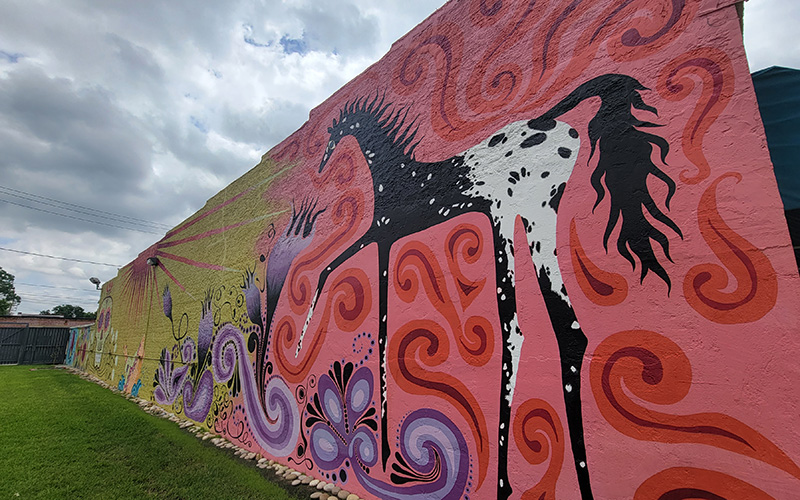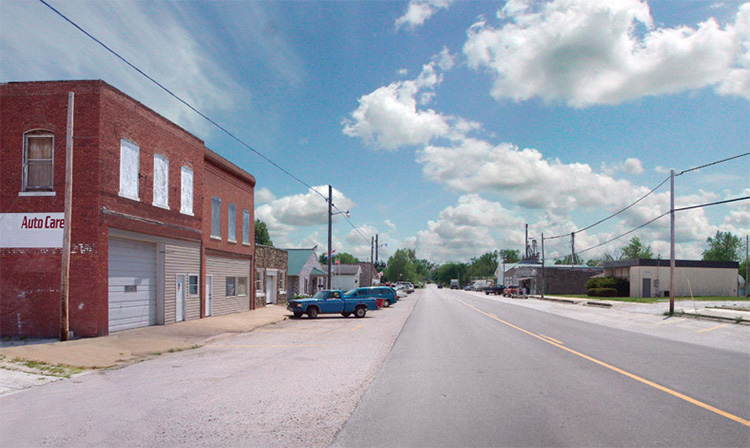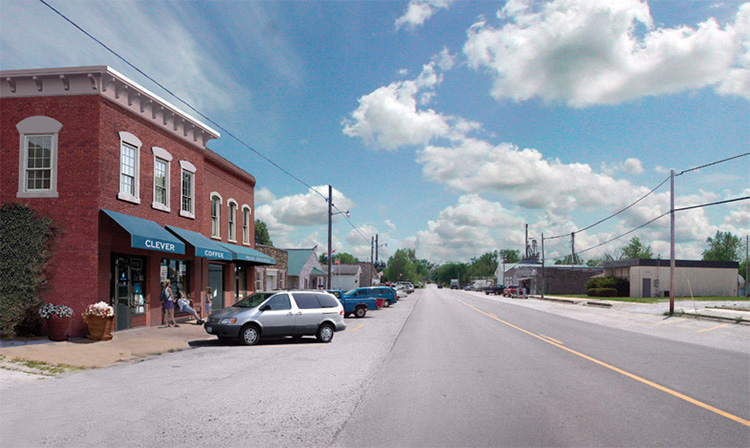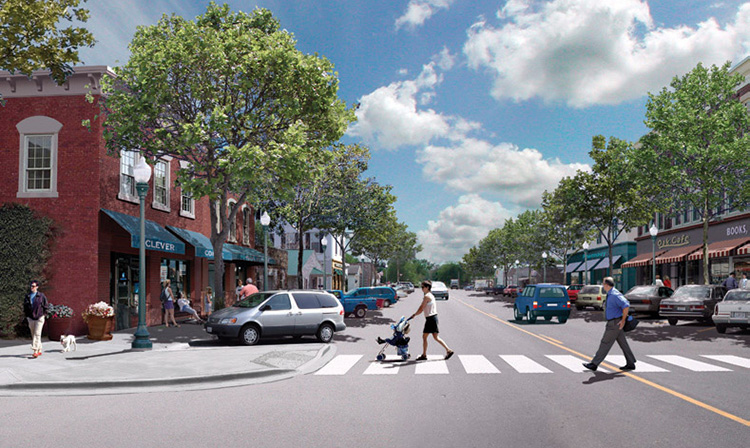On This Page
Visitors first experience downtown from the street. Crafting an attractive, pedestrian-friendly streetscape is critical for creating a favorable perception of the area, encouraging visitors to spend time downtown and patronize nearby businesses.
Elements of Attractive, Pedestrian-Friendly Streetscapes
Streetscape improvements take time to fully form, but there are a variety of short- and long-term changes that can create a better experience for visitors.
To generate immediate excitement downtown, communities can implement simple, low-cost solutions called instant impact aimed at improving an area’s appeal.
Pedestrian Improvements
Sidewalks, crosswalks, and pedestrian signals make walking safe, convenient, and appealing. Decorative paving that reflects the area’s cultural and architectural history (stamped concrete, inlaid brick, etc.) can be used to delineate pedestrian areas and direct traffic.
Temporary Road Diets*
Paint, cones, planters, or road buttons can be used to create a temporary bicycle lane or curbside parking, allowing communities to test different design strategies without making significant investments in new infrastructure.
Landscaping*
Trees along the sidewalk shade pedestrians and improve the area’s appearance, among other benefits. Placing planters along the street can be a low-cost way to create immediate visual interest and demonstrate the community’s commitment toward improving downtown. To do this, organize a planting event where volunteers can beautify the area and get their hands dirty.
Lighting*
Lighting improves the visibility, safety, and overall ambience of the street, and can be used to draw attention to nearby businesses and attractions. Banners and other decorative features can be attached to light posts, highlighting different aspects of the community. String lights or accent lighting can create more visual interest in an area without high costs.
Street Furniture
Well-designed benches, trash cans, bicycle racks, and other amenities can make spending time downtown more pleasant. Outdoor dining can generate activity along the street, while providing restaurants with additional seating and increased visibility.

Façade Improvements*
Improving the appearance of downtown buildings enhances visitors’ perception of the area, while highlighting its unique history and architecture. Decorating windows of vacant buildings can help prospective owners and tenants imagine what types of businesses could be located there, while providing visual interest.
Public Art*
Murals and other public art can promote the community’s natural and cultural assets, while creating a visually appealing streetscape.
*For more information on these different techniques, review H-GAC’s Instant Impact Guide.
Development Strategies - Evolution of Successful Main Streets
Putting these goals into practice, a downtown area may follow this evolution:

Existing Conditions

Short-Term Fixes

Long-Term Investments
Existing Conditions
- Historic buildings have fallen into disrepair.
- Overhead power lines create visual clutter.
- Pedestrians must cross a wide street without marked crosswalks.
- Sidewalks are uneven and have no protection from the elements.
- Vacant storefronts have few street-level windows and doors, limiting their attractiveness to passersby.
Short-Term Fixes
- Large display windows on the ground floor increase pedestrian safety and provide visual interest.
- Adding potted plants and other landscaping is a low-cost way to create a welcoming streetscape.
- Awnings provide shade and include attractive signage for businesses.
- A bench offers additional seating, while increasing activity along the street.
- Unique, historically-appropriate architectural details add visual interest.
Long-Term Investments
- Street trees provide shade and protection from the elements, while improving the appearance of downtown.
- Infill development reflects established building patterns, creating additional space for residences and businesses.
- Crosswalks, curb extensions, and wide sidewalks make walking safer and more convenient.
- Decorative pedestrian-scale lighting improves visibility, safety, and overall ambience.
- Burying utilities reduces visual clutter and creates more space for pedestrian facilities and landscaping.
- A mix of shops, restaurants, and other businesses offer a variety of goods and services, generating activity throughout the day.
Historic Preservation
Historic buildings often found in rural downtowns contribute to the community’s sense-of-place and offer unique spaces for stores, restaurants, offices, housing and other uses.
Local governments can offer financial and regulatory incentives to encourage the rehabilitation of historic structures, improving the streetscape:
Grants for Improvements
Grants, loans, and other financial programs can provide property owners with funding to renovate existing buildings and make other improvements. The Texas Historical Commission compiles a list of funding sources for preservation projects.
Design Guidelines
Design guidelines provide standards for the construction and rehabilitation of buildings downtown. They can address the exterior appearance of buildings, the composition of new structures or additions, and streetscape improvements. These guidelines, which can be voluntary or mandatory, help ensure new development (and redevelopment) reflects the character and scale of existing buildings.
Where historic buildings do not exist or are unsalvageable, cities encourage context-sensitive infill development that reflects the character of the surrounding area. Form-based development codes (development codes focusing on a property’s design rather than use) promote development appropriate for historic downtowns, while providing property owners with flexibility.
Preservation Tax Incentives
Property owners renovating historic buildings can take advantage of federal and state tax incentives, and local governments may grant property tax exemptions for the rehabilitation of those structures. While these programs offer financial benefits, property owners may have to meet additional structural and accounting requirements. For more information about preservation tax incentives, consult the National Park Service or the Texas Historical Commission.
Preservation Tax Incentives
Federal

20% Tax Credit
Those rehabilitating an income-producing building certified as a historic structure by the National Park Service (NPS) may be eligible for a federal tax credit equal to 20% of the rehabilitation costs. Restoration work must meet the Secretary of the Interior’s Standards for Rehabilitation. Owner-occupied residential properties are ineligible to receive this incentive.
10% Tax Credit
Those rehabilitating non-historic, income-producing buildings built prior to 1936 may be eligible for a federal tax credit equal to 10% of the rehabilitation costs. Most exterior walls and internal structural elements must remain in place once the restoration is complete. Residential properties (renter- or owner-occupied) are ineligible to receive this incentive.
Historic Preservation Easements
Owners of historic properties may donate an historic preservation easement to a non-profit organization. These easements permanently protect historic properties by restricting future development and preventing incompatible building modifications. Donors may be eligible for different tax benefits.
State

Texas Historic Preservation Tax Credit Program
Owners rehabilitating certified historic structures may receive tax credits equal to 25% of eligible rehabilitation costs, which can be applied against a business’s franchise tax liability. Restoration work must meet the Secretary of the Interior’s Standards for Rehabilitation.
State Sales Tax Exemption on Labor
Owners of non-residential buildings listed on the National Register of Historic Places may be eligible to receive a sales tax exemption on the labor associated with repairing, restoring or remodeling their properties.
Local

Local taxing authorities may offer tax exemptions for historic properties designated as state or local landmarks.*
Many cities have funding mechanisms to allow for facade improvement grant programs for businesses to rehabilitate older or neglected buildings.
*For state enabling legislation, see Title 1, Subtitle C, Chapter 11, Subchapter A, Sec. 11.24 of the Texas Tax Code.

